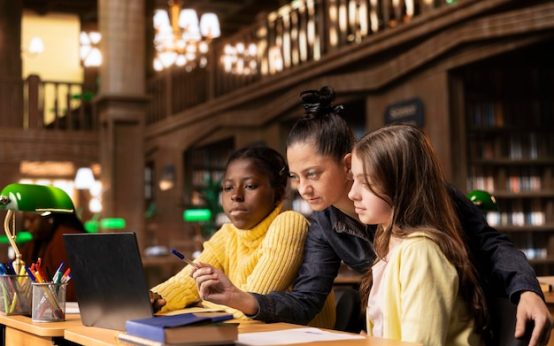Gamification in education enhances student engagement and motivation through interactive learning techniques, overcoming traditional teaching challenges by integrating game mechanics into the classroom.
Incorporating gamification in education can transform the way students engage with learning materials. Have you ever wondered how game-like elements can enhance classroom experiences? This article explores practical strategies to captivate students and improve retention.
Understanding gamification in education
Understanding gamification in education is essential for creating a more interactive learning environment. When educators apply game design elements to learning, they can enhance student motivation and participation. This approach transforms traditional teaching methods into exciting challenges that students look forward to.
What is gamification?
Gamification involves using game-like elements in non-game contexts. In education, this means incorporating aspects like points, badges, and leaderboards into learning experiences. The goal is to encourage students to engage more deeply with the material.
Benefits of gamification in education
There are several advantages to adopting gamification in the classroom:
- Increased motivation: Game elements can make learning feel more rewarding.
- Enhanced engagement: Students are more likely to participate when the content is interactive.
- Improved retention: Learning through play can lead to better memory and understanding.
By utilizing gamification, educators can cater to different learning styles and encourage collaboration among students. This approach helps build a sense of community, making learning feel less isolating.
Another great feature of gamification is the immediate feedback it provides. Students can see their progress in real-time, which can be highly motivating. This instant acknowledgment is often more effective than traditional grading systems.
How to implement gamification in your classroom
To effectively incorporate gamification, consider starting with small changes:
- Introduce a points system for completing assignments.
- Use educational games for review sessions.
- Establish challenges that can be done individually or in teams.
These strategies can help create a more dynamic learning atmosphere. Keeping activities fun and relevant encourages students to keep trying, even when faced with challenging material.
Benefits of gamification for student engagement
Gamification offers many benefits for student engagement that can change the educational landscape. By integrating game mechanics into learning activities, teachers can create a more dynamic and interactive environment for their students.
Enhanced motivation
One of the first benefits is enhanced motivation. Students are naturally drawn to games, and incorporating these elements can spark their interest in the subject matter. When learning feels like a game, students are more likely to participate actively and strive for success.
Greater participation
Gamification also leads to greater participation. As students earn points or achievements, they will want to get involved in more activities. This drive to accumulate rewards encourages a positive learning experience.
- Immediate feedback: Gamified systems provide instant results, helping students to see their progress right away.
- Healthy competition: Leaderboards encourage friendly competition among students, which can boost their engagement.
- Personalized learning: Gamification can cater to individual strengths and preferences, making learning more effective.
Another benefit of gamification is the improved retention of information. When information is presented in a fun way, students are likely to remember it longer. Incorporating storytelling into lessons can also create emotional connections that help students recall the material later.
Moreover, gamification fosters collaboration among students. Group activities and team challenges promote teamwork and communication skills, which are essential in today’s world. This social interaction makes learning more enjoyable and reinforces the material.
Development of critical skills
As students engage with gamified content, they build critical skills such as problem-solving and critical thinking. They learn to navigate challenges and come up with creative solutions, all while enjoying the learning process.
Effective gamification techniques to implement

Implementing effective gamification techniques can significantly enhance the learning experience. By integrating game mechanics into educational settings, teachers can foster a more engaging and motivational environment for students.
Use points and rewards
One technique is to incorporate points and rewards into classroom activities. Students can earn points for completing assignments, participating in discussions, or helping peers. This system encourages friendly competition and motivates students to improve their performance.
Create levels and challenges
Another effective technique is creating levels and challenges. By breaking the curriculum into stages, students can progress at their own pace. Each level can present new challenges that build on the knowledge they’ve gained.
- Define clear goals: Ensure that each level has specific learning objectives to keep students focused.
- Encourage collaboration: Team challenges can help students work together and build social skills.
- Incorporate storytelling: A narrative can make challenges more exciting and relatable for students.
In addition, immediate feedback is crucial in gamification. Using quizzes or interactive activities can provide students with instant results. This approach allows them to understand their strengths and weaknesses right away, making adjustments to their learning process as needed.
Another helpful technique is the use of badges and achievements. Rewarding students with badges for completing specific tasks or mastering skills visually represents their accomplishments. This recognition can boost students’ confidence and motivate them to continue striving for success.
Utilize technology
Integrating technology into gamification techniques also has significant advantages. Online platforms can provide a variety of interactive tools and games. These tools often offer engaging ways for students to practice and reinforce their learning.
Additionally, mobile applications can bring gamification into students’ hands. Students can learn and compete even outside the classroom, further enhancing their educational experience.
Measuring the impact of gamification
Measuring the impact of gamification in education is vital to understand its effectiveness. When educators apply gamification techniques, it is important to track how these changes affect student engagement and learning outcomes.
Set clear objectives
To start, set clear objectives for what you hope to achieve with gamification. These could include increasing class participation, improving test scores, or enhancing student motivation. By defining goals, you provide a benchmark to measure success.
Gather data
Collecting data is crucial for measuring impact. Utilize surveys, assessments, and observations to gather information on student engagement and performance. This can include:
- Pre- and post-assessments: Comparing test scores before and after implementing gamification can show changes in knowledge.
- Student feedback: Surveys can help assess how students feel about gamified activities and their motivation levels.
- Participation rates: Track attendance and participation in gamified lessons to measure engagement.
Analyzing this data over time can reveal trends and insights into how gamification is impacting students. Keep in mind that the effects may not be immediate, and consistent monitoring is necessary for a full assessment.
Furthermore, peer observations and teacher reflections can provide qualitative insights into the effectiveness of gamification. Discussing experiences with other educators can lead to valuable feedback for improving strategies.
Adjusting strategies
Based on the collected data, be prepared to adjust your gamification strategies. If certain techniques are not producing the desired results, consider experimenting with new approaches. Flexibility is essential in adapting to the needs of your students.
To ensure lasting benefits from gamification, create opportunities for continuous feedback. Regularly engaging with students about their experiences can lead to enhancements that make the learning experience even more effective.
Challenges in adopting gamification in education
Adopting gamification in education comes with several challenges that educators must navigate. While gamification can enhance student engagement, it is important to understand the potential obstacles that may arise during implementation.
Resistance to change
One common challenge is resistance to change from both educators and students. Some teachers may feel comfortable with traditional teaching methods and hesitate to try new approaches. Students may also be skeptical about changing the way they learn.
Resource limitations
Another issue is the availability of resources. Not all schools have the technology needed to implement gamified activities effectively. Insufficient access to computers or educational software can hinder the adoption process.
- Budget constraints: Many schools face tight budgets that limit potential purchases for gamified tools.
- Training needs: Teachers may require additional training to understand how to use new gamification tools effectively.
- Time constraints: Educators often have limited classroom time to explore and implement new strategies.
Furthermore, integrating gamification into existing curricula can be challenging. It requires careful planning to ensure that game elements align with educational goals. Educators must strike a balance between fun and the seriousness of learning.
In addition, not all students respond positively to gamified learning. Some may prefer traditional methods and may not engage fully with gamified content. It is crucial for teachers to recognize different learning preferences and adapt their approaches accordingly.
Assessment difficulties
Finally, assessing the effectiveness of gamification can pose a challenge. Standard testing methods may not capture the improvements in engagement and motivation that gamification aims to achieve. Finding appropriate assessment strategies that align with gamified activities can be complex for educators.
Despite these challenges, many educators find that the benefits of gamification outweigh the difficulties. By addressing these obstacles and being flexible, teachers can create a more engaging learning environment.
Conclusion:
In summary, adopting gamification in education offers many benefits, including increased student engagement and motivation. While there are challenges to overcome, such as resistance to change and resource limitations, educators can find effective strategies to implement gamification successfully. By focusing on clear objectives and continuously measuring the impact, teachers can enhance the learning experience and create a dynamic classroom environment.
Here’s a quick overview of the main points:
FAQ – Questions About Gamification in Education
What are the main benefits of gamification in education?
Gamification enhances student engagement, motivation, and improves knowledge retention through interactive learning experiences.
What challenges might teachers face when adopting gamification?
Teachers may encounter resistance to change, resource limitations, and difficulties in integrating gamification into existing curricula.
How can the impact of gamification be measured?
The impact can be measured through assessments, student feedback, and tracking participation rates to evaluate engagement and effectiveness.
What techniques can be used to successfully implement gamification?
Effective techniques include using points and rewards, creating levels and challenges, and integrating technology for a more interactive learning experience.

 FreeLearningTools: Unlock Your Potential with These Gems
FreeLearningTools: Unlock Your Potential with These Gems  College Admissions: Understanding the Latest Standardized Testing Changes
College Admissions: Understanding the Latest Standardized Testing Changes  Understanding the Latest Changes in College Admission Tests
Understanding the Latest Changes in College Admission Tests